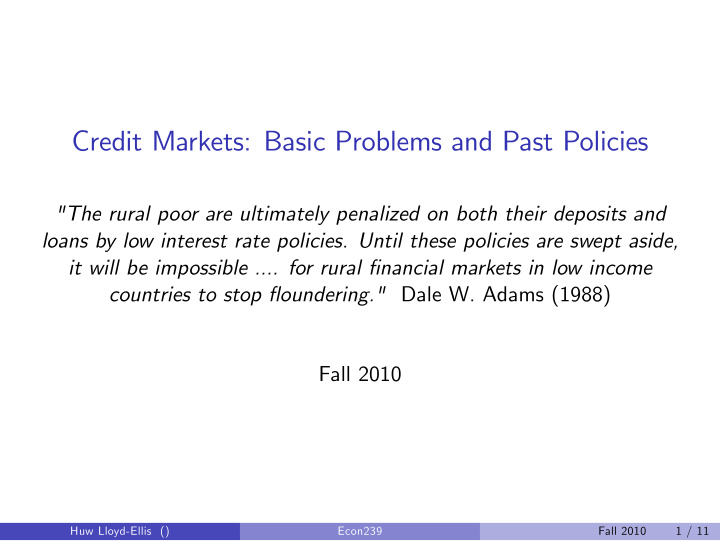



Credit Markets: Basic Problems and Past Policies "The rural poor are ultimately penalized on both their deposits and loans by low interest rate policies. Until these policies are swept aside, it will be impossible .... for rural …nancial markets in low income countries to stop ‡oundering." Dale W. Adams (1988) Fall 2010 Huw Lloyd-Ellis () Econ239 Fall 2010 1 / 11
Basic Problems (circa 1950): Low quantity of domestic savings — major constraint on investment, especially in manufacturing Dualistic credit market , ! formal sector — commercial and government run banks serving urban sector and large landowners , ! informal sector — small scale lenders and agricultural cooperatives serving small scale rural borrowers and the informal urban sector Skewed distribution of credit access — a source of persistent and widening wealth disparity. Huw Lloyd-Ellis () Econ239 Fall 2010 2 / 11
The Development Planning View Dominant paradigm (1960s / 70s) Monopolistic moneylenders, especially in rural areas Lack of “…nancial depth” , ! low savings due to uncertainty regarding potential bank failure and ine¤ective legal systems , ! lack of alternatives …nancial assets catering to varying needs of potential savers/lenders. Huw Lloyd-Ellis () Econ239 Fall 2010 3 / 11
Policy Strategy: “put the moneylender in his place” All India Rural Credit Survey (1950) , ! development banks to lend at low rates to rural borrowers initially …ll savings gap with tax revenue and foreign loans/aid Eventually banks would become self–…nancing BUT , ! failed to drive out informal moneylenders , ! development banks did not become …nancially viable , ! access to formal credit remained skewed towards large landowners Huw Lloyd-Ellis () Econ239 Fall 2010 4 / 11
The Chicago School View Informal sector is competitive, but risky and costly due to , ! seasonal activity , ! systemic risk , ! geographically dispersed customers , ! absence of collateral — land is often untitled , ! di¢culty of enforcing repayment ) lack of information re‡ects acquisition costs ) high interest rates re‡ect risk not monopoly power Huw Lloyd-Ellis () Econ239 Fall 2010 5 / 11
Lender’s risk hypothesis: Pro…t per $ loaned = p ( 1 + r ) � ( 1 + i ) where r = lending rate i = marginal cost of funds p = probability of repayment , ! Competition ) zero economic pro…ts , ! risk–adjusted interest rate r = 1 + i � 1 p Huw Lloyd-Ellis () Econ239 Fall 2010 6 / 11
Interest S(r) Rate r d r * r I(r) Savings, S(r d ) I* Investment S(r) Figure: Implications of Interest Rate Ceiling Huw Lloyd-Ellis () Econ239 Fall 2010 7 / 11
Policy implication: government intervention is bound to fail , ! removal of interest rate ceilings , ! credit market liberalization pushed by external lenders BUT , ! localized information limits competition , ! interest rates often negatively related to risk , ! information is a public good — social bene…ts exceed private bene…ts , ! no explanation for other institutional characteristics Huw Lloyd-Ellis () Econ239 Fall 2010 8 / 11
Example 1: Credit Markets in Chambar, Pakistan Irfan Aleem Informal sector = 75% of rural lending Mean Interest Rates: Formal = 12%, Informal = 79% Non–specialization by lenders: interlinking of loan and commodity contracts Signi…cant entry rates into lending Borrower loyalty High degree of duality: , ! Informal sector: no collateral, but low default rates , ! Formal sector: collateral but high default rates Signi…cant entry rates into lending Borrower loyalty Huw Lloyd-Ellis () Econ239 Fall 2010 9 / 11
Example 2: Nakhan Rachisma Province, Thailand Share of credit from informal sector = 56% (90% in 1975) Mean Interest Rates: Formal = 12%, Informal = 90% Small borrowers use informal sector. Variety of contractual relationships Formal “peer monitoring” system informal lenders’ incomes co–vary with borrowers. Borrower loyalty and ease of entry Huw Lloyd-Ellis () Econ239 Fall 2010 10 / 11
Example 3: Informal Sectors of West Africa Main sources of …nance in order of importance: Family and friends Moneylenders Suppliers’ credit Esusus and Tontines (ROSCAs) , ! 1/2 of rural residents in Cameroon, Cote d’Ivoire, Congo, Liberia, Togo and Nigeria Non–Governmental Organizations Credit Unions Banks — do not serve informal enterprises Huw Lloyd-Ellis () Econ239 Fall 2010 11 / 11
Recommend
More recommend